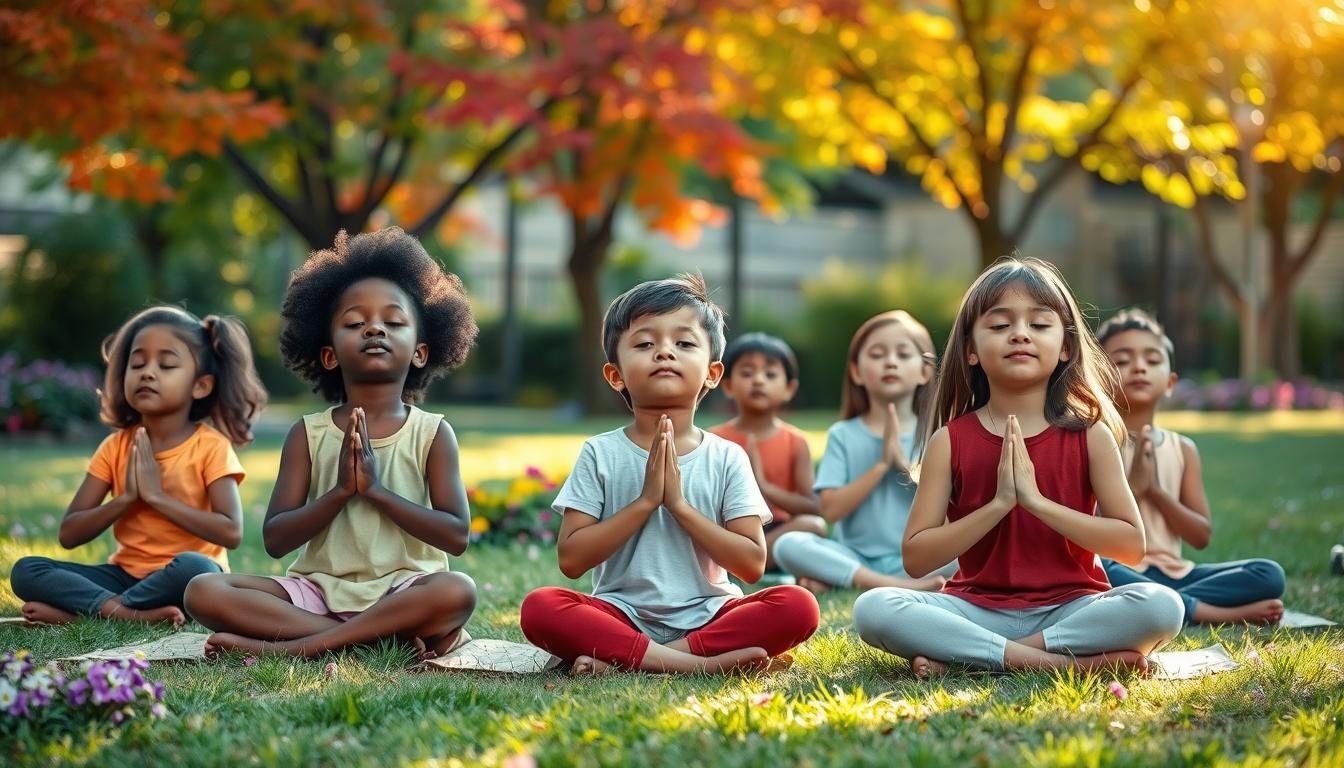Deep breathing is a great way to relax, and it works for kids and adults alike. By teaching kids deep breathing techniques, we give them a useful tool. It helps them in many situations, like when they’re feeling stressed or need to calm down.
Deep breathing can make kids feel more relaxed and focused. It also helps lower their heart rate and increase oxygen levels. This can make them feel calmer.
The Power of Deep Breathing for Kids
Deep breathing exercises are great for kids. They help in many ways, making kids feel better. These exercises calm the body, clear the mind, and lower stress and anxiety.
Benefits of Deep Breathing Exercises for Children
When kids face tough emotions or situations, deep breathing helps. It calms them down. It also makes them focus on something simple, taking their mind off worries.
- Lowers heart rate and blood pressure, promoting a sense of relaxation
- Increases oxygen levels in the body, which can have a soothing effect
- Helps children focus and improve concentration
- Reduces symptoms of anxiety and stress
- Improves respiratory function, benefiting children with conditions like asthma
Adding deep breathing to kids’ daily lives is a smart move. It helps them stay mentally healthy and strong. Mental health experts see more kids and teens struggling. Deep breathing is a simple, yet powerful way to help them.
Teaching kids about deep breathing and making it fun can help them handle their feelings. Regular practice can greatly improve their health and happiness.
Introduction to Breathing Exercises
Breathing exercises are great for kids to lower stress and feel better. They teach kids to breathe deeply, calming their minds and bodies. There are many types, like feather breathing to balloon breathing, that kids can enjoy and learn from.
Belly breathing, or diaphragmatic breathing, is easy and effective for kids. It makes the belly go up and down with each breath. This helps kids control their feelings, handle stress, and stay focused.
Kids can also try other breathing exercises, like counting breaths or imagining bubbles. They can use visual aids like feathers or balloons. These activities can be part of daily routines or classroom activities, helping kids relax when they’re stressed or anxious.
Teaching kids different breathing exercises helps them learn to manage their feelings. It’s a simple way to help them feel better and grow strong from a young age.
Belly Breathing: A Simple Yet Powerful Technique
Belly breathing, also known as diaphragmatic breathing, is a simple yet effective breathing exercise for kids. It helps them relax and manage stress. It also boosts their overall well-being.
Steps to Teach and Practice Belly Breathing
Begin by having your child breathe normally and notice their feelings. Then, have them place one hand on their belly and the other on their chest. Tell them to breathe in deeply through their nose, feeling their belly rise.
As they breathe out slowly through their mouth, guide them to feel their belly lower. Encourage a slow exhale by having them pretend to blow out candles or make a noise with their breath. Repeat the exercise several times, focusing on deep, belly-centered breathing.
Regular practice of belly breathing helps children relax and manage stress. It improves their emotional well-being. By adding this technique to their daily routine, you empower your child with essential coping skills and self-regulation abilities.
Fun Breathing Exercises for Kids
Getting kids to do breathing exercises can be fun and engaging. By adding playful elements, you can grab their attention. This makes them want to learn more about breathing. Here are some fun breathing techniques to try with kids:
Imaginative Ideas to Engage Children
- Pretend to be a bunny – Take three quick sniffs in through the nose, followed by one long exhale out through the mouth, like a little bunny in the garden.
- Blow out the birthday candles – Encourage your child to draw a deep breath in through the mouth and blow it out strong, pretending to extinguish the candles on a make-believe birthday cake.
- Hiss like a snake – Have your child pretend to be a snake and hiss as they exhale slowly through the mouth.
- Buzz like a bumblebee – Ask your child to make a humming or buzzing noise as they exhale, imitating the sound of a bumblebee.
These fun exercises keep kids interested and make breathing practice enjoyable. By using their imagination, you can teach them about deep breathing in a fun way.
Simple Breathing Exercises for Kids to Reduce Stress
Belly breathing is just the start. There are many other simple breathing exercises that help kids deal with stress and anxiety. These fun, structured techniques give kids tools to calm down when they feel overwhelmed.
“Snake breath” is one such exercise. Kids breathe in through their nose, pause, then exhale slowly through their mouth, making a soft hissing sound. “Bunny breath” is quick, shallow sniffs like a rabbit. “Bumblebee breath” involves breathing in and then humming or buzzing on the exhale.
- 5-5-10 breathing: Inhale for 5 seconds, hold for 5 seconds, exhale for 10 seconds
- 7-11 breathing: Inhale for 7 seconds, exhale for 11 seconds
These exercises help kids develop self-regulation skills and find calm in chaos. By adding these breathing methods to their daily lives, kids learn to handle their emotions better. They become more balanced and resilient.
Snake Breath and Bubble Breath
Teaching kids breathing exercises can help them deal with stress and anxiety. Two fun methods are snake breath and bubble breath.
The snake breath exercise is simple. Kids breathe in through their nose, pause, and then exhale slowly through their mouth. They make a soft hissing sound, like a snake. This helps them focus on their breath and feel calm.
Bubble breath is another fun option. Kids breathe in deeply and then blow out slowly to make imaginary bubbles. This encourages deep, controlled breathing, which relaxes them.
These creative breathing techniques make the practice fun for kids. By trying snake breath exercises and bubble breath activities, they learn valuable breathing techniques for kids. These can help them manage their emotions and reduce stress.
There are many other breathing techniques for children to try. Some include:
- Triangle Breathing
- Square Breathing
- Star Breathing
- Lazy 8 Breathing
- Whale Breath
- Bunny Breath
- Bumblebee Breath
- Volcano Breaths
By trying different creative breathing exercises, kids can find what works best for them. They can use these techniques every day to relax, manage stress, and stay well.
Bumblebee Breath and Hand Breathing
Breathing exercises are a fun way for kids to relax and find calm. “Bumblebee breath” and “hand breathing” are two great techniques. They help kids focus and manage their feelings.
“Bumblebee breath” has kids breathe in through their nose and then exhale with a soft humming sound. This sound is like a bumblebee buzzing. It makes them feel calm and helps them stay focused.
“Hand breathing” is another cool technique. Kids use their hands to guide their breathing. They place their index finger on the base of their thumb and breathe in as they move their finger up. Then, they breathe out as they move it down. They do this for each finger, taking five deep breaths. This makes the exercise fun and interactive.
Both techniques let kids try different breathing patterns while moving their hands. They help kids deal with stress, improve focus, and feel better overall.
Adding these fun breathing exercises to a child’s routine is great. It gives them tools to handle stress, build resilience, and improve their mental and physical health.
Visualization Techniques for Deep Breathing
Adding visualization to breathing exercises can make them more fun and effective for kids. It turns deep breathing into a fun and memorable activity for them.
Engaging the Imagination
For instance, kids can imagine blowing up a hot air balloon as they breathe out. Or, they can pretend to be a flower blooming when they breathe in and closing when they breathe out. They can also picture themselves in a calm place, like a forest or the beach, and breathe in sync with their thoughts.
This kind of visualization helps kids focus better. It makes the breathing practice more fun and meaningful for them. By using their imagination, visualization breathing exercises for kids become more enjoyable and effective. The imaginative breathing techniques for children help them relax and focus better, leading to better well-being.
Using guided breathing activities for kids that mix deep breathing with creative thinking is very helpful. It’s a great way to manage stress and anxiety.
Breathing exercises with visualization can help students focus and relax better. Using these visualization breathing exercises for kids before or after certain activities can help. It supports students in managing their feelings and improving their concentration.
Tips for Teaching Breathing Exercises
Teaching how to teach breathing exercises to kids can greatly improve their well-being. When teaching breathing techniques for children, focus on making it comfortable and fun. Start by teaching deep breathing exercises when the child is relaxed, not when they’re stressed.
This way, they can learn without feeling pressured. It’s important to introduce breathing exercises for kids early, even in toddler years. Use counting or pictures to help them breathe, and adjust your method to fit each child’s needs. The goal is to make breathing exercises feel comfortable and fun, so kids will use them when they need to calm down or focus.
- Introduce breathing exercises when the child is calm, not during a stressful moment.
- Start teaching deep breathing at a young age, as early as the toddler years.
- Use counting or imagery to guide the breathing and find what works best for each child.
- Make the breathing exercises feel comfortable and fun to encourage regular practice.
By following these best practices for instructing breathing techniques for children, you can teach kids breathing exercises effectively. This will help them manage stress, improve focus, and boost their mental health.
Conclusion
Breathing exercises are a great way to help kids deal with stress and big feelings. Teaching them simple techniques like belly breathing and bumblebee breath is very helpful. These methods help kids relax and handle tough situations better.
Deep breathing is a free and easy way for kids to calm down. Adding these exercises to their daily routine can greatly improve their well-being. It can also help with focus, behavior, and even physical health like blood pressure.
Teaching kids to breathe deeply is key to their health and happiness. It gives them tools to manage stress and find peace. This is a valuable skill for their whole life.





